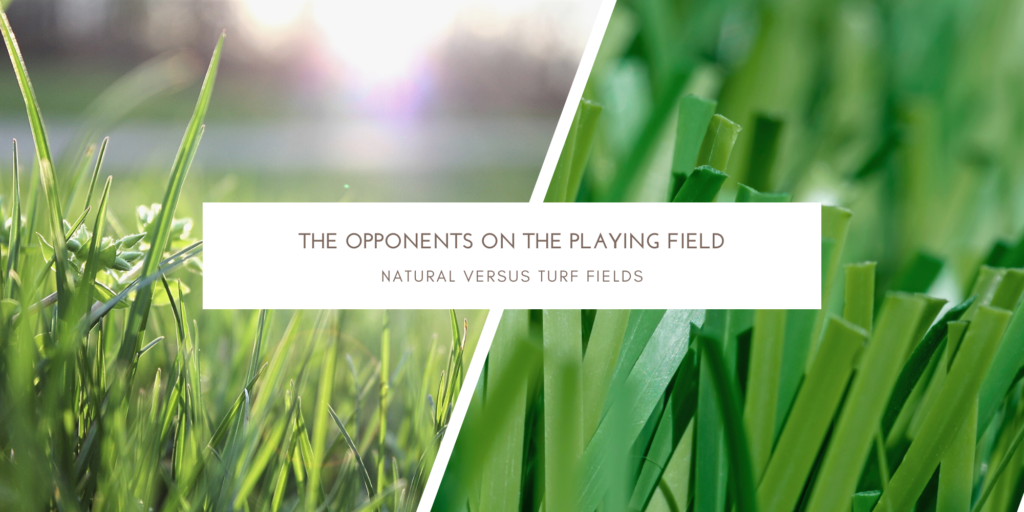
Fields are an important part of everyday life. They are where people gather to watch recreational sports, exercise, and even to just sit and relax. Especially during the pandemic, fields have allowed people to safely meet outside and get fresh air.
But have you ever considered what impact these fields may have on the environment?
As you are watching the local youth soccer game, the environmental impacts fields can have probably don’t cross your mind — but their impacts are all too real. Especially as climate change continues to disrupt our regular activities, the effect that fields — whether made of turf or green grass — have on climate change and the environment must be an important consideration.
Fields are too crucial to communities across the planet to just stop using or get rid of all together, so the next best thing to do is to mitigate the environmental effects they may have. It’s time to take a closer look at the composition of fields and how they are impacting our planet.
What exactly are fields made of?
Fields are typically made of two materials: turf and grass.
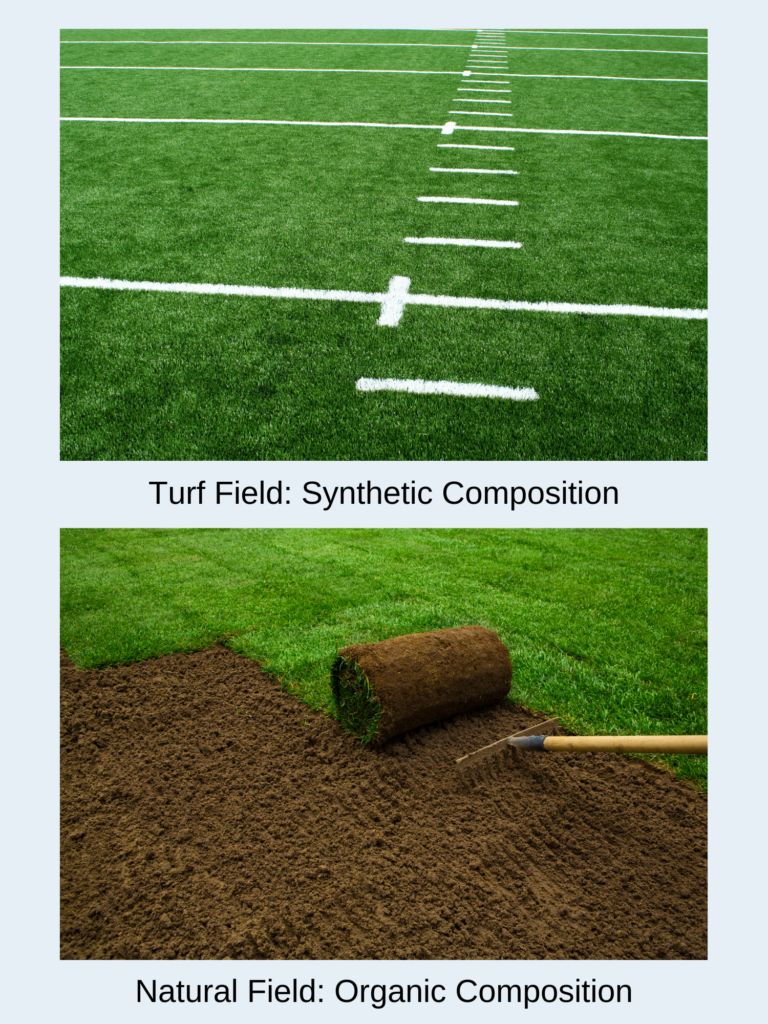
A turf field is primarily composed of artificial materials such as plastic, cork, rubber, and gravel. There are many varieties and brands of turf fields such as Original AstroTurf , field turf, Astroplay, spin turf, and matrix turf.
All of them vary slightly in the exact construction and composition, but the main trend among these types of fields is that they are all made of synthetic — or man made, often not biodegradable — materials.
On the other hand, natural fields are mostly composed of grass, sod, and soil. While there are different types of soil that can be used, these fields are typically all grouped under the “natural” title because they are made of organic components.
Both types of fields are used by parks, recreational areas, professional facilities, and individual homes, so it is up to the owner of the facility to make the decision on whether to install a turf or natural field.
But which material is better for the environment, while still considering human needs?
While it is important to consider detrimental environmental impacts, investors and stakeholders must also consider factors such as the safety of people using the fields and how much the field will cost. Turf and natural fields vary within factors so it is worth going into a deeper analysis to help all stakeholders choose.
What are the differences?
There are many differences in impact between turf and natural fields, but we will focus on: Emissions, user health and performance, weather effects, and cost.
1. Emissions
Emissions from fields are described using the life cycle assessment (LCA) process. The LCA is a method of measuring the environmental impacts of a material or product over its entire lifetime: its creation, use, maintenance and disposal. Measuring the total amount of CO2 equivalent emissions — the emissions primarily responsible for environmental effects such as global warming — can help give a better understanding of how the field impact the environment.
Turf fields can produce between 0.6 and 1.2 kilograms of CO equivalent per kilogram of material over their lifetime; this measurement takes into account that most turf fields are made of recycled materials such as shredded tires and pieces of cork. While it is generally good to recycle as much as possible, there unfortunately is not much that can be done with these synthetic fields after they are no longer able to be used.
Natural fields typically produce around 0.01 kilograms of CO2 equivalent per kilogram of material over their lifetime. The soil and grass components of the fields will not produce emissions, but the irrigation systems needed to water the fields require energy that then produces emissions.
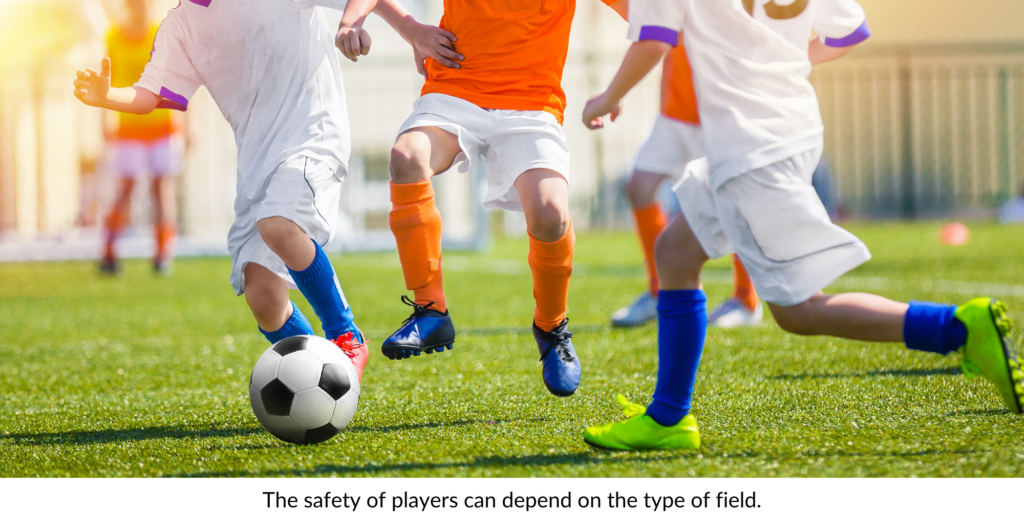
2. Player Health
Health is an important factor that must be considered, especially as we currently face a pandemic. There is evidence that turf fields may harbor more bacteria than natural fields — cite the specific evidence. To get past this, turf fields are frequently sanitized to remove animal droppings and human bodily fluids. While research is yet to be finalized on how COVID-19 maintains on surfaces such as fields, most bacteria and viruses have a longer permanence time on turf fields in comparison to natural fields.
Some also believe that more injuries result when playing on turf fields, but research published by the British Journal of Sports Medicine showed that the frequency and intensity of injuries actually depends on the type of sport being played. For example, American football has higher rates of injury than soccer because American football involves higher levels of contact between players. Therefore, the material of the field will not necessarily affect injury rates, but stakeholders could consider athletes’ preferences.
3. Weather Impacts on Fields
Another point of concern for field users is the temperature of the field. The organic components of natural fields prevent the surface from overheating. However, in rainy areas, natural fields can be wet and muddy. A wet and muddy field can also be concerning for athlete safety if proper measures are not taken to keep the field maintained during rainy seasons.
On the other hand, turf fields can majorly overheat. An analysis published by ScienceDirect in 2014 found that the temperature of the turf field depends on the type of infill material used. For example, turf fields made from recycled rubber tires will have higher surface temperatures than a turf field with plastic infill.
Turf fields can also contribute to the “heat island” effect. Heat islands, as described by the EPA, are “urbanized areas that experience higher temperatures than outlying areas,” where “structures such as buildings, roads, and other infrastructure absorb and re-emit the sun’s heat more than natural landscapes such as forests and water bodies.”
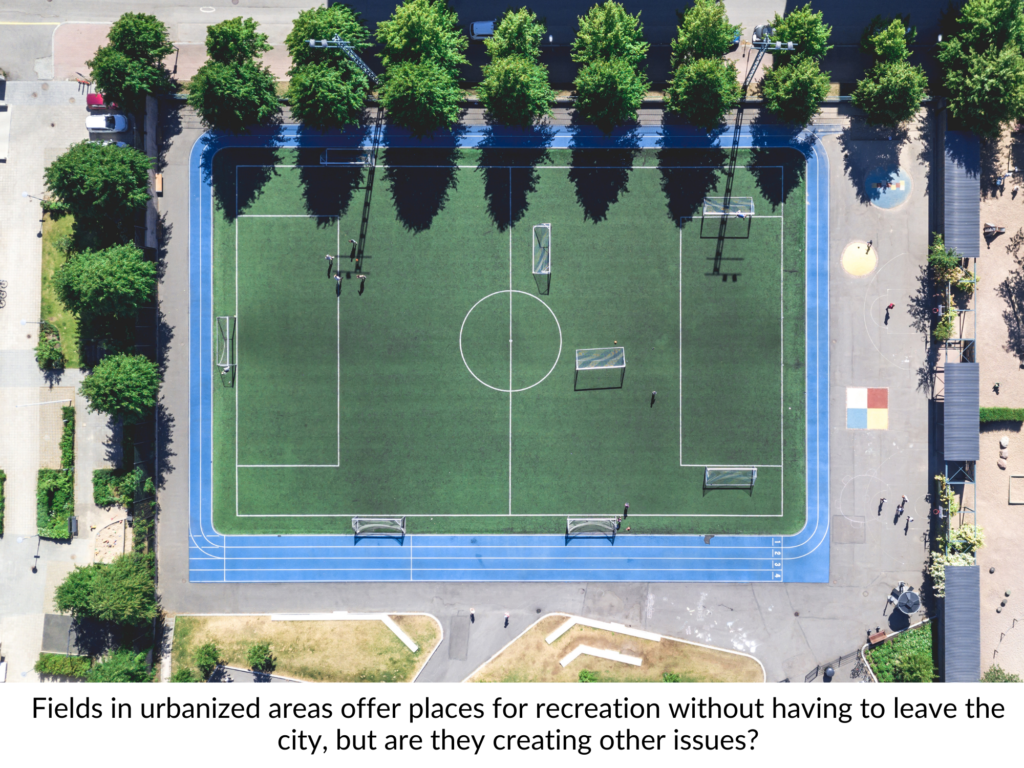
The heat island effect increases the ambient temperature in an area and can contribute to global warming and overall rising temperatures.
There are pros and cons to turf and natural fields in terms of temperatures, but ultimately, the external ambient temperature and humidity of a location will affect the field.
4. Cost
The cost of turf fields and natural fields depends on the installation and maintenance costs. Installation costs refer to the initial cost of creating the field, and maintenance costs are the costs associated with keeping the field well kept so community members can continue to use them.
Installation Costs
For turf fields, the typical cost of installation is $6.50 – $11.00 per square foot. For natural fields, the typical cost of installation is $2.25 – $5.25 per square foot. Turf fields have higher installation costs because bringing in artificial materials require more resources compared to working with natural materials that are already located in the area where the field will be built.
The average size of a football field is 57,600 square feet, so the installation cost of a turf field is about $374,400 to $633,600 per field. The installation cost of a natural field with the same dimensions can range from about $129,600 to $302,400 per field.
Maintenance Costs
The annual maintenance costs of natural fields is higher than artificial fields because natural fields must be watered and reseeded. The average lifetime of a field is 15 years for both turf and natural fields.
The maintenance costs of a turf field are about $0.49 per square foot per lifetime so the overall maintenance cost of a turf field over its lifetime is about $28,575 per lifetime. The maintenance costs of a natural field are about $4.25 per square foot per lifetime so the overall maintenance cost of a natural field is about $244,917 per lifetime.
Ultimately, the overall cost of field construction and maintenance can depend on external factors such as which country the field is being built, how the land will need to be reshaped to accommodate the field, and additional factors. These numbers reflect the cost of the field itself and trends to consider when deciding which field to implement.
What will fields look like in the future… maybe even after the pandemic?
In a time of social distancing, fields are an essential part of well being and safe recreation. Fields allow for community members to get exercise and spend time outdoors without worrying about walking past others. They give children the opportunity to get fresh air after spending hours on their computers for school.
While fields are important for individual activities, they are also an important part of professional facilities. They are the “offices” of professional athletes, and (in non-pandemic times) can even be the floor of an amphitheatre where many people relax or stand to see their favorite artists perform.
In the future, we will hopefully be able to return to the shared use of recreational public fields so that they are more accessible to members of the community. For now however, fields will continue to be an important part of socially distant activities during a pandemic.
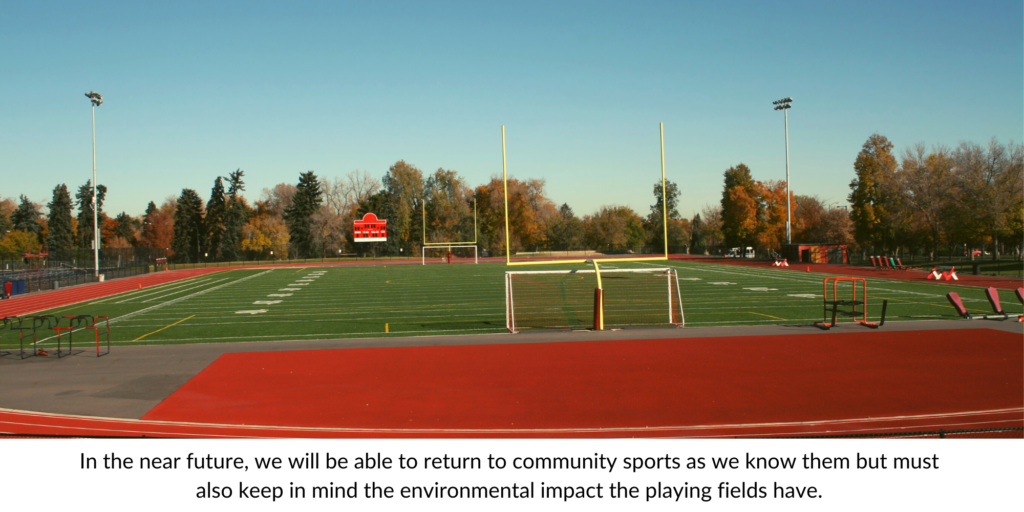
So which field should you choose?
There are pros and cons to implementing artificial turf or natural fields, but ultimately it is up to stakeholders to decide which field will fit their needs. It is up to stakeholders to decide which is better for their facility given the factors presented and maybe even additional considerations. Even though the fields may be opponents, they still serve the same purpose: to unite teams, players, spectators, and supporters all in one place.
Arranged Sources:
- For emissions:
- For cost:
- For health:
- For heat:
- General Source:





